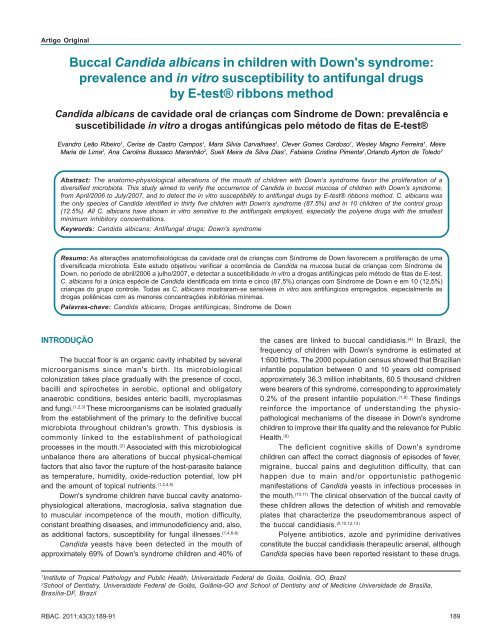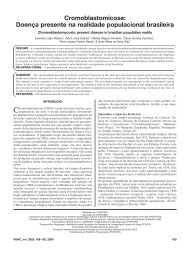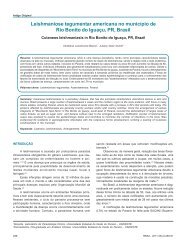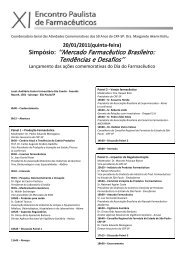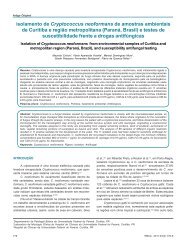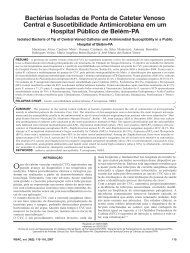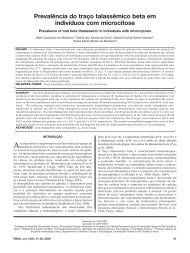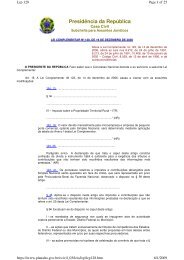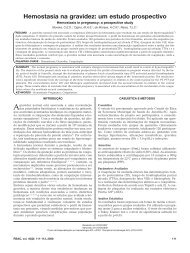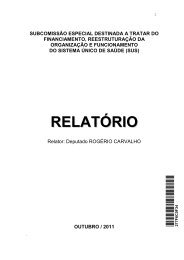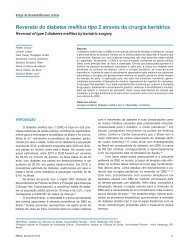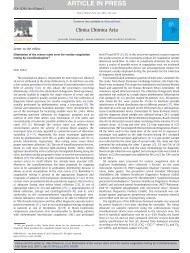Buccal Candida albicans in children with Down's syndrome
Buccal Candida albicans in children with Down's syndrome
Buccal Candida albicans in children with Down's syndrome
Create successful ePaper yourself
Turn your PDF publications into a flip-book with our unique Google optimized e-Paper software.
Artigo Orig<strong>in</strong>al<br />
<strong>Buccal</strong> <strong>Candida</strong> <strong>albicans</strong> <strong>in</strong> <strong>children</strong> <strong>with</strong> <strong>Down's</strong> <strong>syndrome</strong>:<br />
prevalence and <strong>in</strong> vitro susceptibility to antifungal drugs<br />
by E-test® ribbons method<br />
<strong>Candida</strong> <strong>albicans</strong> de cavidade oral de crianças com Síndrome de Down: prevalência e<br />
suscetibilidade <strong>in</strong> vitro a drogas antifúngicas pelo método de fitas de E-test®<br />
Evandro Leão Ribeiro 1 , Cerise de Castro Campos 1 , Mara Silvia Carvalhaes 1 , Clever Gomes Cardoso 1 , Wesley Magno Ferreira 1 , Meire<br />
Maria de Lima 2 , Ana Carol<strong>in</strong>a Bussaco Maranhão 2 , Sueli Meira da Silva Dias 1 , Fabiana Crist<strong>in</strong>a Pimenta 1 ,Orlando Ayrton de Toledo 2<br />
Abstract: The anatomo-physiological alterations of the mouth of <strong>children</strong> <strong>with</strong> <strong>Down's</strong> <strong>syndrome</strong> favor the proliferation of a<br />
diversified microbiota. This study aimed to verify the occurrence of <strong>Candida</strong> <strong>in</strong> buccal mucosa of <strong>children</strong> <strong>with</strong> <strong>Down's</strong> <strong>syndrome</strong>,<br />
from April/2006 to July/2007, and to detect the <strong>in</strong> vitro susceptibility to antifungal drugs by E-test® ribbons method. C. <strong>albicans</strong> was<br />
the only species of <strong>Candida</strong> identified <strong>in</strong> thirty five <strong>children</strong> <strong>with</strong> <strong>Down's</strong> <strong>syndrome</strong> (87.5%) and <strong>in</strong> 10 <strong>children</strong> of the control group<br />
(12.5%). All C. <strong>albicans</strong> have shown <strong>in</strong> vitro sensitive to the antifungals employed, especially the polyene drugs <strong>with</strong> the smallest<br />
m<strong>in</strong>imum <strong>in</strong>hibitory concentrations.<br />
Keywords: <strong>Candida</strong> <strong>albicans</strong>; Antifungal drugs; <strong>Down's</strong> <strong>syndrome</strong><br />
Resumo: As alterações anatomofisiológicas da cavidade oral de crianças com Síndrome de Down favorecem a proliferação de uma<br />
diversificada microbiota. Este estudo objetivou verificar a ocorrência de <strong>Candida</strong> na mucosa bucal de crianças com Síndrome de<br />
Down, no período de abril/2006 a julho/2007, e detectar a suscetibilidade <strong>in</strong> vitro a drogas antifúngicas pelo método de fitas de E-test.<br />
C. <strong>albicans</strong> foi a única espécie de <strong>Candida</strong> identificada em tr<strong>in</strong>ta e c<strong>in</strong>co (87,5%) crianças com Síndrome de Down e em 10 (12,5%)<br />
crianças do grupo controle. Todas as C. <strong>albicans</strong> mostraram-se sensíveis <strong>in</strong> vitro aos antifúngicos empregados, especialmente as<br />
drogas poliênicas com as menores concentrações <strong>in</strong>ibitórias mínimas.<br />
Palavras-chave: <strong>Candida</strong> <strong>albicans</strong>; Drogas antifúngicas; Síndrome de Down<br />
INTRODUÇÃO<br />
The buccal floor is an organic cavity <strong>in</strong>habited by several<br />
microorganisms s<strong>in</strong>ce man's birth. Its microbiological<br />
colonization takes place gradually <strong>with</strong> the presence of cocci,<br />
bacilli and spirochetes <strong>in</strong> aerobic, optional and obligatory<br />
anaerobic conditions, besides enteric bacilli, mycroplasmas<br />
and fungi. (1,2,3) These microorganisms can be isolated gradually<br />
from the establishment of the primary to the def<strong>in</strong>itive buccal<br />
microbiota throughout <strong>children</strong>'s growth. This dysbiosis is<br />
commonly l<strong>in</strong>ked to the establishment of pathological<br />
processes <strong>in</strong> the mouth. (2) Associated <strong>with</strong> this microbiological<br />
unbalance there are alterations of buccal physical-chemical<br />
factors that also favor the rupture of the host-parasite balance<br />
as temperature, humidity, oxide-reduction potential, low pH<br />
and the amount of topical nutrients. (1,2,4,5)<br />
<strong>Down's</strong> <strong>syndrome</strong> <strong>children</strong> have buccal cavity anatomophysiological<br />
alterations, macroglosia, saliva stagnation due<br />
to muscular <strong>in</strong>competence of the mouth, motion difficulty,<br />
constant breath<strong>in</strong>g diseases, and immunodeficiency and, also,<br />
as additional factors, susceptibility for fungal illnesses. (1,4,6-8)<br />
<strong>Candida</strong> yeasts have been detected <strong>in</strong> the mouth of<br />
approximately 69% of <strong>Down's</strong> <strong>syndrome</strong> <strong>children</strong> and 40% of<br />
the cases are l<strong>in</strong>ked to buccal candidiasis. (4) In Brazil, the<br />
frequency of <strong>children</strong> <strong>with</strong> <strong>Down's</strong> <strong>syndrome</strong> is estimated at<br />
1:600 births. The 2000 population census showed that Brazilian<br />
<strong>in</strong>fantile population between 0 and 10 years old comprised<br />
approximately 36.3 million <strong>in</strong>habitants, 60.5 thousand <strong>children</strong><br />
were bearers of this <strong>syndrome</strong>, correspond<strong>in</strong>g to approximately<br />
0.2% of the present <strong>in</strong>fantile population. (1,9) These f<strong>in</strong>d<strong>in</strong>gs<br />
re<strong>in</strong>force the importance of understand<strong>in</strong>g the physiopathological<br />
mechanisms of the disease <strong>in</strong> <strong>Down's</strong> <strong>syndrome</strong><br />
<strong>children</strong> to improve their life quality and the relevance for Public<br />
Health. (9)<br />
The deficient cognitive skills of <strong>Down's</strong> <strong>syndrome</strong><br />
<strong>children</strong> can affect the correct diagnosis of episodes of fever,<br />
migra<strong>in</strong>e, buccal pa<strong>in</strong>s and deglutition difficulty, that can<br />
happen due to ma<strong>in</strong> and/or opportunistic pathogenic<br />
manifestations of <strong>Candida</strong> yeasts <strong>in</strong> <strong>in</strong>fectious processes <strong>in</strong><br />
the mouth. (10,11) The cl<strong>in</strong>ical observation of the buccal cavity of<br />
these <strong>children</strong> allows the detection of whitish and removable<br />
plates that characterize the pseudomembranous aspect of<br />
the buccal candidiasis. (5,10,12,13)<br />
Polyene antibiotics, azole and pyrimid<strong>in</strong>e derivatives<br />
constitute the buccal candidiasis therapeutic arsenal, although<br />
<strong>Candida</strong> species have been reported resistant to these drugs.<br />
1<br />
Institute of Tropical Pathology and Public Health, Universidade Federal de Goiás, Goiânia, GO, Brazil<br />
2<br />
School of Dentistry, Universidade Federal de Goiás, Goiânia-GO and School of Dentistry and of Medic<strong>in</strong>e Universidade de Brasília,<br />
Brasília-DF, Brazil<br />
RBAC. 2011;43(3):189-91 189
Ribeiro EL, Campos CC, Carvalhaes MS, Cardoso CG, Ferreira WM, Lima MM, et al.<br />
The first two antifungal groups act on the ergosterol of the fungal<br />
cell and the pyrimid<strong>in</strong>e drugs act compromis<strong>in</strong>g the formation of<br />
RNA necessary for the expression of the fungal prote<strong>in</strong>s. (6,13-15)<br />
The objective of the present work was to verify the<br />
occurrence of <strong>Candida</strong> yeasts <strong>in</strong> the buccal mucosa of <strong>children</strong><br />
<strong>with</strong> <strong>Down's</strong> <strong>syndrome</strong> and to detect <strong>in</strong> vitro the susceptibility<br />
of <strong>Candida</strong> stra<strong>in</strong>s isolated aga<strong>in</strong>st polyene, azole and<br />
pyrimid<strong>in</strong>e drugs.<br />
MATERIAL AND METHODS<br />
<strong>Candida</strong> samples<br />
Hundred and twenty (120) saliva secretion samples of<br />
<strong>children</strong> <strong>with</strong> or <strong>with</strong>out the 21 st chromosome pathology, used<br />
<strong>in</strong> this work, were due to a case-control study. Saliva secretion<br />
samples were collected <strong>with</strong> a swab from the jugal mucosa of<br />
40 <strong>children</strong> <strong>with</strong> <strong>Down's</strong> <strong>syndrome</strong> (test group) and 80 ones<br />
<strong>with</strong>out the <strong>syndrome</strong> constitut<strong>in</strong>g the control group. All the<br />
<strong>children</strong> presented <strong>in</strong>tact buccal mucosa and were not us<strong>in</strong>g<br />
any medication. The <strong>children</strong> belonged to an age group rang<strong>in</strong>g<br />
from 0 to 10 years old and were assisted, between April/2006<br />
and July/2007, at the Pediatric Dental Cl<strong>in</strong>ic of the School of<br />
Dentistry of Universidade Federal de Goiás (CO/FO/UFG) <strong>in</strong><br />
Goiânia, state of Goiás, Brazil. The present study was previously<br />
accepted by the Ethics Committee <strong>in</strong> the Human and Animal<br />
Medical Investigation of the Cl<strong>in</strong>ic Hospital of Universidade<br />
Federal de Goiás (HC/UFG) and the <strong>children</strong>'s parents or<br />
people responsible gave their consent to the <strong>in</strong>vestigators <strong>in</strong><br />
order they could conduct the work.<br />
Petri dishes <strong>with</strong> one homogenized mixture of 25mL of dextrose<br />
agar previously cooled to 45ºC and 25 mL of filtered RPMI-<br />
1640 agar. After solidification, 0.6 mL of each <strong>Candida</strong> sample<br />
was added to the Petri dishes and sowed <strong>with</strong> a swab. Shortly<br />
after absorption of the suspension by the agar, E-test® ribbons<br />
of the antifungal drugs used were added and the plates<br />
ma<strong>in</strong>ta<strong>in</strong>ed at 30ºC for 24 hours. MIC was considered as be<strong>in</strong>g<br />
the po<strong>in</strong>t where the microorganism growth <strong>in</strong>hibition <strong>in</strong> the<br />
agar <strong>in</strong>tercepted the E-test® ribbon. (12,15)<br />
RESULTS<br />
<strong>Candida</strong> was detected <strong>in</strong> 37.5% (45/120) of the samples,<br />
all belong<strong>in</strong>g to the species C. <strong>albicans</strong>. In <strong>Down's</strong> <strong>syndrome</strong><br />
group, 87.5% (35/40) of yeasts were isolated, <strong>in</strong> contrast <strong>with</strong><br />
only 12.5% (10/80) <strong>in</strong> the control group (<strong>children</strong> <strong>with</strong>out the<br />
<strong>syndrome</strong>), thus demonstrat<strong>in</strong>g a significant statistical<br />
relationship (Table 1). All <strong>Candida</strong> <strong>albicans</strong> stra<strong>in</strong>s from the<br />
test and control groups (<strong>children</strong> <strong>with</strong> and <strong>with</strong>out <strong>Down's</strong><br />
<strong>syndrome</strong>) showed <strong>in</strong> vitro susceptibility to the antifungal drugs<br />
used <strong>in</strong> drug diffusion test by E-test® (Table 2).<br />
Isolation and identification<br />
After the homogenization of each sal<strong>in</strong>e solution<br />
conta<strong>in</strong><strong>in</strong>g saliva secretion, the material was sowed <strong>in</strong><br />
duplicate <strong>in</strong> Sabouraud Dextrose Agar (SDA) <strong>with</strong> 0.1mg.mL -<br />
1<br />
of chloramphenicol and ma<strong>in</strong>ta<strong>in</strong>ed at room temperature<br />
for 15 days. The white-yellowish colonies were identified<br />
through the presence/absence of germ tube <strong>in</strong> bov<strong>in</strong>e fetal<br />
serum, clamidospores formation <strong>in</strong> corn-meal agar <strong>with</strong><br />
tween 80 and biochemical tests (carbon assimilation and<br />
fermentation). (8,10)<br />
It was accomplished by apply<strong>in</strong>g the χ² (Chi-squared)<br />
test to correlate the <strong>in</strong>dexes of oral carriage of <strong>Candida</strong> yeasts<br />
<strong>in</strong> <strong>children</strong> <strong>with</strong> and <strong>with</strong>out <strong>Down's</strong> <strong>syndrome</strong>. The obta<strong>in</strong>ed<br />
values were considered statisticaly significant when p < 0.05.<br />
In vitro susceptibility<br />
<strong>Candida</strong> stra<strong>in</strong>s susceptibility tests aga<strong>in</strong>st antifungal<br />
drugs (amphoteric<strong>in</strong> B, ketoconazole, fluconazole, itraconazole<br />
and 5-fluorcytos<strong>in</strong>e) were done <strong>in</strong> vitro by means of E-test®<br />
ribbons (ABBIODISK) for the determ<strong>in</strong>ation of the m<strong>in</strong>imum<br />
<strong>in</strong>hibitory concentration (MIC). The <strong>Candida</strong> yeasts isolated,<br />
after double subsequent cultivations to obta<strong>in</strong> purity and fungal<br />
satisfactory viability, were <strong>in</strong>dividually added to 5 mL of<br />
sterilized water and the cellular density adjusted on a spectrophotometer<br />
to 85% transmittance <strong>in</strong> 530 nm wavelength,<br />
result<strong>in</strong>g <strong>in</strong> a solution <strong>with</strong> an <strong>in</strong>oculum vary<strong>in</strong>g from 0.5x10 2<br />
to 2.5x10 3 CFU/mL (colony form<strong>in</strong>g units per milliliter). The<br />
DISCUSSION<br />
<strong>Buccal</strong> candidiasis is a fungal <strong>in</strong>fection that affects humans<br />
dur<strong>in</strong>g all their lives. However, childhood and old age stand out<br />
as the two most favorable life periods for these yeasts <strong>in</strong>fectious<br />
manifestations. (3,5)<br />
190 RBAC. 2011;43(3):189-91
<strong>Buccal</strong> <strong>Candida</strong> <strong>albicans</strong> <strong>in</strong> <strong>children</strong> <strong>with</strong> <strong>Down's</strong> <strong>syndrome</strong>: prevalence and <strong>in</strong> vitro susceptibility to<br />
antifungal drugs by E-test® ribbons method<br />
<strong>Down's</strong> <strong>syndrome</strong> favours alterations of the buccal cavity<br />
of the <strong>children</strong> whose bear this chromosomal alteration. Such<br />
alterations allow the tissue of the mouth to be populated by<br />
<strong>Candida</strong> yeasts as coloniz<strong>in</strong>g and/or pathogenic microorganisms,<br />
as <strong>in</strong> the case of angular cheilitis, <strong>in</strong> an <strong>in</strong>cidence<br />
of 16% of the <strong>children</strong>. (1,2,11) Periodontal disease can be related<br />
<strong>with</strong> microbiological alelobiosis, which <strong>in</strong>cludes <strong>Candida</strong><br />
isolates, due to the formation of dental plaque, low buccal<br />
hygiene, neutropenic compromis<strong>in</strong>g and repair capacity<br />
deficiency present <strong>in</strong> <strong>children</strong> <strong>with</strong> this chromosomal mutation<br />
(fast bone loss). (1)<br />
The low occurrence of dental caries <strong>in</strong> <strong>Down's</strong> <strong>syndrome</strong><br />
<strong>children</strong> when compared to other pathologies which cause<br />
mental retardation, br<strong>in</strong>gs the secondary l<strong>in</strong>k<strong>in</strong>g of <strong>Candida</strong> to<br />
Streptococcus mutans as ma<strong>in</strong> agents of the cariogenic dental<br />
process. (3,5,11) Another factor that would favour the high carriage<br />
of <strong>Candida</strong> <strong>in</strong> the mouth of <strong>children</strong> <strong>with</strong> <strong>Down's</strong> <strong>syndrome</strong> is<br />
the verification of the physical-chemical alterations of saliva<br />
secretion. Variation of salivary pH and sodium, calcium and<br />
bicarbonate ions concentration, among other substances,<br />
seem to affect <strong>Candida</strong> mouth survival, as it keeps pH<br />
oscillation between acidity and alkal<strong>in</strong>ity. (2,11)<br />
It is also added to this chromosomal alteration, the<br />
situation of the immune system of <strong>children</strong> <strong>with</strong> <strong>Down's</strong><br />
<strong>syndrome</strong>. Neutrophils, T lymphocytes and natural killer cells<br />
functions are abnormal, the first ones are associated <strong>with</strong><br />
lower rates of IgG 2<br />
and IgG 4<br />
immunoglobul<strong>in</strong>s and the others<br />
<strong>with</strong> altered superoxide desmutase favour<strong>in</strong>g the action of<br />
Staphylococcus and <strong>Candida</strong> as common <strong>in</strong>fectious agents<br />
<strong>in</strong> the mouth. (9) In our study, we verified that the buccal cavity of<br />
these <strong>children</strong> showed highly carriage of <strong>Candida</strong> yeasts <strong>with</strong><br />
the prevalence of 87.5%, confirm<strong>in</strong>g the high predisposition of<br />
these <strong>in</strong>dividuals to buccal candidiasis. This prevalence was<br />
shown to be statistically significant. Carstedt et al. verified that<br />
69% of the 55 Swedish <strong>children</strong> and adolescents <strong>with</strong> <strong>Down's</strong><br />
<strong>syndrome</strong> carried <strong>Candida</strong> stra<strong>in</strong>s <strong>in</strong> the mouth as compared<br />
to 35% of <strong>in</strong>dividuals <strong>in</strong> the control group. (4)<br />
The available <strong>Candida</strong> <strong>in</strong>fections antifungal treatment<br />
<strong>in</strong>cludes polyene, azole and pyrimid<strong>in</strong>e drugs. Constant<br />
f<strong>in</strong>d<strong>in</strong>gs of <strong>Candida</strong> yeasts resistant <strong>in</strong> vitro to these drugs<br />
constitute a frequent cl<strong>in</strong>ical-laboratory concern. Polyene<br />
antibiotics may have their pharmacological action reduced by<br />
alterations of the fungal plasmatic membrane lipids<br />
composition and the fungal catalase activity <strong>in</strong>creased reduc<strong>in</strong>g<br />
the sensibility to the oxidative damages of these drugs. The<br />
azoles, <strong>in</strong> general, show lower efficacy aga<strong>in</strong>st <strong>Candida</strong> stra<strong>in</strong>s<br />
due to the low bid<strong>in</strong>g aff<strong>in</strong>ity of the 14 α-demetilase to the<br />
antifungal drug, added to the <strong>in</strong>crease of its enzymatic activity<br />
and high content of ergosterol <strong>in</strong> the fungus. On the other hand,<br />
the fungal resistance to pyrimid<strong>in</strong>e drugs is probably favored<br />
by the loss or mutation of any associated enzymes responsible<br />
for its conversion and <strong>in</strong>corporation to the transcription of<br />
fungus RNA. In the case of C. <strong>albicans</strong> stra<strong>in</strong>s the nucleic acid<br />
constitution affected by mutations, <strong>in</strong>hibit the production of UMP<br />
PP-fosforibosil transferase. (13,14)<br />
The use of <strong>in</strong> vitro susceptibility test aga<strong>in</strong>st antifungal<br />
drugs by E-test® drug diffusion <strong>in</strong> solid media used <strong>in</strong> this<br />
study, was performed as a consequence of its easy<br />
methodological procedure and also to corroborate <strong>with</strong> the<br />
rules extolled by NCCLS/CLSI (National Committee for Cl<strong>in</strong>ical<br />
Laboratory Standards/Cl<strong>in</strong>ical Laboratory Standards Institute)<br />
(Atlanta/USA). However, this method does not yet have E-test®<br />
ribbons for antifungal drugs such as nystat<strong>in</strong> and clotrimazole<br />
which have shown to be effective <strong>in</strong> vitro and <strong>in</strong> vivo aga<strong>in</strong>st<br />
buccal candidiasis. (13,14) In our study, we verified that all C.<br />
<strong>albicans</strong> isolates, regardless of the chromosomal alteration<br />
witnessed <strong>in</strong> the <strong>children</strong> <strong>with</strong> <strong>Down's</strong> <strong>syndrome</strong>, were<br />
sensitive <strong>in</strong> vitro to the antifungal drugs. Accord<strong>in</strong>g to<br />
Thornsberry and Sabath (15) the IC 50<br />
(concentration of the drug<br />
able to <strong>in</strong>hibit the growth of the microorganism by 50%) detected<br />
for each drug tested, aga<strong>in</strong>st the <strong>Candida</strong> yeasts studied, was<br />
<strong>in</strong> agreement <strong>with</strong> the spectrum of the plasmatic level that<br />
each antifungal drug can reach <strong>in</strong> the human subject<br />
(resistance levels for the fungi isolates that present MIC ≥ 8<br />
µg/mL for azole derivatives, MIC ≥ 2 µg/mL for amphoteric<strong>in</strong> B<br />
and MIC ≥ 64 µg/mL for 5-fluorcytos<strong>in</strong>e), constitut<strong>in</strong>g an effective<br />
therapeutic resource for the treatment of buccal candidiasis <strong>in</strong><br />
the <strong>children</strong> <strong>with</strong> <strong>Down's</strong> <strong>syndrome</strong>.<br />
REFERENCES<br />
1. Mustacchi Z. Síndrome de Down: aspectos clínicos e odontológicos. Editora<br />
CID, São Paulo, 1990.<br />
2. Negroni M. Microbiología estomatológica. Panmericana. Madrid. 1999.<br />
3. Ribeiro EL, Pires CCC, Rocha FP, Castro JS. Carreamento de leveduras de<br />
<strong>Candida</strong> na cavidade oral de crianças com síndrome de Down. Rev Soc Bras<br />
Med Trop. 1998;31:219.<br />
4. Caslstedt K, Krekmanova L, Dahloff G, Ericsson B, Braathen G, Modeer T.<br />
Oral carriage of <strong>Candida</strong> species <strong>in</strong> <strong>children</strong> and adolescents <strong>with</strong> <strong>Down's</strong><br />
<strong>syndrome</strong>. Int J Paediatr Dent. 1996;6(2):95-100.<br />
5. Ribeiro EL, Campos CC, Crespo AMC, Castro JS, Rocha FP, Alves M et al.<br />
Detecção de <strong>Candida</strong> <strong>albicans</strong> fosfolipidolíticas isoladas da saliva de crianças<br />
com síndrome de Down. Acta Médica Portuguesa. 2002; 3:171-4.<br />
6. Colombo AL, Barchiesi, F, Mogough DA, R<strong>in</strong>aldi MG. Comparison of Etest and<br />
National Committee for Cl<strong>in</strong>ical Laboratory Standards broth macrodilution method<br />
for azole antifungal susceptibity test<strong>in</strong>g. J Cl<strong>in</strong> Microbiol. 1995;33 (3):535-40<br />
7. Desai SS. Down <strong>syndrome</strong>: a review of the literature. Oral Surg Oral Med Oral<br />
Pathol Oral Radiol Endod. 1997;84(3):279-85.<br />
8. Kregen-van Rij NJW. The yeast: a taxonomic study. Editora Elsivier,<br />
Amsterdam, 1984.<br />
9. Instituto Brasileiro de Geografia e Estatística. Censo populacional 2000.<br />
www.ibge.gov.br. Acesso em 28.09.2007.<br />
10. Bolso G. Doenças <strong>in</strong>fecciosas e parasitárias. Aspectos clínicos. Vigilância<br />
epidemiológica e medidas de Controle. M<strong>in</strong>istério da Saúde. Fundação Nacional<br />
de Saúde. Brasília,1999.<br />
11. Roncari AM, Rodrigues AB, Elias MS. Síndrome de Down e odontologia.<br />
Investigação. 2002;6:70-4.<br />
12. Richardson MD, Warnock DW. Fungal <strong>in</strong>fections. 2nd. Oxford: Blackwell. 1997.<br />
13. Zaitz C, et al. Compêndio de Micologia de Médica. Editora Medsi; Rio de<br />
Janeiro, 1998.<br />
14. Ribeiro MA. Exoenzimas e mecanismos moleculares de resistência ao<br />
fluconazol de C. <strong>albicans</strong> isoladas de mulheres HIV positivas. Tese de<br />
Doutorado. Universidade de São Paulo, São Paulo, 2002.<br />
15. Thornsberry C, Sabath LD. Aproximate concentration of antimicrobial agents<br />
achieved <strong>in</strong> blood. In: Manual of Cl<strong>in</strong>ical Microbiology. 4a ed. E.H. Lennette<br />
A. American Society of Microbiology 1985.<br />
Autor correspondente<br />
Evandro Leão Ribeiro<br />
Pathogenic Fungi Laboratory,<br />
Institute of Tropical Pathology and Public Heath,<br />
Universidade Federal de Goiás<br />
Rua 85A nº 60 Apto 1501, Setor Sul<br />
74080-020 – Goiânia, GO, Brazil<br />
evandro0@terra.com.br<br />
RBAC. 2011;43(3):189-91 191


